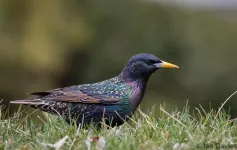Starling success traced to rapid adaptation
Genetic evolution doesn't always take millions of years
2021-02-09
(Press-News.org) Ithaca, NY--Love them or hate them, there's no doubt the European Starling is a wildly successful bird. A new study from the Cornell Lab of Ornithology examines this non-native species from the inside out. What exactly happened at the genetic level as the starling population exploded from just 80 birds released in New York City's Central Park in 1890, peaking at an estimated 200 million breeding adults spread all across North America? The study appears in the journal Molecular Ecology.
"The amazing thing about the evolutionary changes among starling populations since they were introduced in North America is that the changes happened in a span of just 130 years in parallel with a huge expansion in the bird's range and population size," says lead author Natalie Hofmeister, a doctoral candidate at the Cornell Lab. "For a long time we didn't think that was possible--that it took millions of years for genetic mutations to change a genome."
The genetic differences found among North American starlings are very subtle. In fact, after researchers sequenced the genomes of birds from widely distributed locations around the United States, the genomes were all remarkably alike--any starling could undoubtedly mate successfully with another, no matter where they're originally from. But the researchers did find the genetic signatures of change in areas of the genome that control how starlings adapt to variations in temperature and rainfall. Study authors concluded the birds had undergone "rapid local adaptation," adjusting to conditions not found in their native European range.
Another key factor is movement. The study points out that there's a lot of movement among starlings. All that movement means starlings kept establishing new populations as they spread westward, and each population had to adapt to new environments. The adaptation may not have resulted from a new mutation but from an existing genetic variation in the founding population.
"A genetic variation that might not have been useful in one environment could turn out to be very beneficial in another," Hofmeister explains. "So, a variation related to temperature and rainfall that enhanced survival became more common in a new environment." The massive size of the total starling population across North America meant these gene variants could be passed along across the generations.
European Starlings in North America are unusual in another way. Species with a highly restricted gene pool--a genetic bottleneck--are more likely to become extinct because of fertility issues associated with in-breeding, a problem that endangered animals also face. The introduction of just 80 birds in Central Park (released in an attempt to introduce all the birds mentioned in Shakespeare's plays to North America) was one of many attempted introductions in other parts of the country. It's possible the resulting gene flow among these populations prevented the species from dying out. It's an area of speculation ripe for further study.
"What I think is really cool is that the starlings in North America appear to have adapted to different conditions across the range," Hofmeister says. "So, it wasn't just that they reproduced really quickly, and then just kept reproducing. It's that they specialized once they arrived in new areas."
Despite their success and large numbers, the European Starling is now in steep decline, like so many other species in North America. The current population is half the size it was 50 years ago--down from an estimated 166.2 million breeding birds in 1970 to 85.1 million (Rosenberg et. al. Science 2019) . The species is also declining in Europe.
Though starlings are reviled for some of their less admirable habits and their impact on native species, Hofmeister says they're fascinating birds and really quite beautiful. And they're allowing scientists to follow one of the many threads that influence avian evolution.
INFORMATION:
Reference:
Natalie R. Hofmeister, Scott J. Werner, Irby J. Lovette (2021) Environmental correlates of genetic variation in the invasive European starling in North America. Molecular Ecology.
[Attachments] See images for this press release:

ELSE PRESS RELEASES FROM THIS DATE:
2021-02-09
The term "algae" is used to refer to over 72,500 identified aquatic species. The size of algae is up to tens of meters, however, most (about 80%) of the species are much smaller - they comprise the microalgae group. Microalgae are rich in nutrients and biologically active substances such as proteins, carbohydrates, lipids, vitamins, pigments and others. These components are widely used in food, cosmetic, chemical and energy industries. Biotechnology of microalgae has multiple advantages: they are a renewable and sustainable resource, more productive than terrestrial plants due to their high growth rate and lack of seasonality ...
2021-02-09
LAWRENCE -- Traditional burial in a graveyard has environmental costs. Graves can take up valuable land, leak embalming chemicals and involve nonbiodegradable materials like concrete, as well as the plastic and steel that make up many caskets. But the other mainstream option -- cremation -- releases dangerous chemicals and greenhouse gasses into the environment.
So, what's an environmentalist to do when making plans for the end of life?
A new study from the University of Kansas in the journal Mortality details how older environmentalists consider death care and how likely they are to choose "green" burials and other eco-friendly options.
"This article is specifically asking if older adult environmentalists consider how their bodies are going to ...
2021-02-09
GAINESVILLE, Fla. --- A ruler and scale can tell archaeologists the size and weight of a fragment of pottery - but identifying its precise color can depend on individual perception. So, when a handheld color-matching gadget came on the market, scientists hoped it offered a consistent way of determining color, free of human bias.
But a new study by archaeologists at the Florida Museum of Natural History found that the tool, known as the X-Rite Capsure, often misread colors readily distinguished by the human eye.
When tested against a book of color chips, the machine failed to produce correct color scores in 37.5% of cases, even though its software system included the same set of chips. In an analysis of fired ...
2021-02-09
Individually, California blackworms live an unremarkable life eating microorganisms in ponds and serving as tropical fish food for aquarium enthusiasts. But together, tens, hundreds, or thousands of the centimeter-long creatures can collaborate to form a "worm blob," a shape-shifting living liquid that collectively protects its members from drying out and helps them escape threats such as excessive heat.
While other organisms form collective flocks, schools, or swarms for such purposes as mating, predation, and protection, the Lumbriculus variegatus worms are unusual in their ability to braid themselves together to accomplish tasks that unconnected individuals cannot. A new study reported by researchers at ...
2021-02-09
HOUSTON - (Feb. 9, 2021) - Finding a needle in a haystack is hard enough. But try finding a specific molecule on the needle.
Rice University researchers have achieved something of the sort with a new genome editing tool that targets the supporting players in a cell's nucleus that package DNA and aid gene expression. Their work opens the door to new therapies for cancer and other diseases.
Rice bioengineer Isaac Hilton, postdoctoral researcher and lead author Jing Li and their colleagues programmed a modified CRISPR/Cas9 complex to target specific histones, ubiquitous epigenetic proteins that keep DNA in order, ...
2021-02-09
RIVERSIDE, Calif. -- A team led by astronomers at the University of California, Riverside, has found that some dwarf galaxies may today appear to be dark-matter free even though they formed as galaxies dominated by dark matter in the past.
Galaxies that appear to have little to no dark matter -- nonluminous material thought to constitute 85% of matter in the universe -- complicate astronomers' understanding of the universe's dark matter content. Such galaxies, which have recently been found in observations, challenge a cosmological model used by astronomers called Lambda Cold Dark Matter, or LCDM, where all galaxies are surrounded by a massive and extended dark matter halo.
Dark-matter-free galaxies are not well understood in the astronomical community. ...
2021-02-09
UCLA RESEARCH ALERT
FINDINGS
In a study of mice, researchers at the UCLA Jonsson Comprehensive Cancer Center have identified a new approach that combines an anti-psychotic drug, a statin used to lower high cholesterol levels, and radiation to improve the overall survival in mice with glioblastoma. Glioblastoma is one of the deadliest and most difficult-to-treat brain tumors. Researchers found the triple combination extended the median survival 4-fold compared to radiation alone.
BACKGROUND
Radiation therapy is part of the standard-of-care treatment regimen for glioblastoma, often helping prolong the survival of patients. However, survival times have not improved significantly over the past two decades and attempts to improve the efficacy ...
2021-02-09
The construction of a major railway through Kenya will have long-term environmental impacts on the area, suggesting more work needs to be done to limit the damage on future infrastructure projects, a major study reveals.
The biggest impact of the Standard Gauge Railway (SGR), which runs from Mombasa to Nairobi, was pollution and contamination of soil, water and air, as well as disruption of natural processes.
The research, led by the University of York and part of the Development Corridors Partnership project, also showed environmental issues as a result of breaking up large areas of habitat into smaller, more isolated patches, that may not be able to support long-term natural processes.
The SGR project was given the go-ahead following the completion ...
2021-02-09
A multi-institutional team became the first to generate accurate results from materials science simulations on a quantum computer that can be verified with neutron scattering experiments and other practical techniques.
Researchers from the Department of Energy's Oak Ridge National Laboratory; the University of Tennessee, Knoxville; Purdue University and D-Wave Systems harnessed the power of quantum annealing, a form of quantum computing, by embedding an existing model into a quantum computer.
Characterizing materials has long been a hallmark of classical supercomputers, which encode information using a binary system of bits that are each assigned a value of either 0 or 1. But quantum computers -- in this case, D-Wave's 2000Q - rely on qubits, which can be valued at ...
2021-02-09
Wolves are arguably the most well-studied large predators in the world, yet new research shows there is still a lot to learn about their hunting tactics. Typically, wolves hunt large mammals like moose, deer, and bison in packs by outrunning, outlasting, and exhausting their prey. However, throughout the dense boreal forests in North America and Eurasia, during the summer wolves often hunt beavers by themselves.
But how does a wolf catch a semi-aquatic prey that spends little time on land and never ventures far from the safety of its pond? Turns out with patience, and a lot of waiting.
In a new paper published in the journal Behavioral Ecology, researchers from the University of Minnesota and the Voyageurs Wolf Project--which ...
LAST 30 PRESS RELEASES:
[Press-News.org] Starling success traced to rapid adaptation
Genetic evolution doesn't always take millions of years







